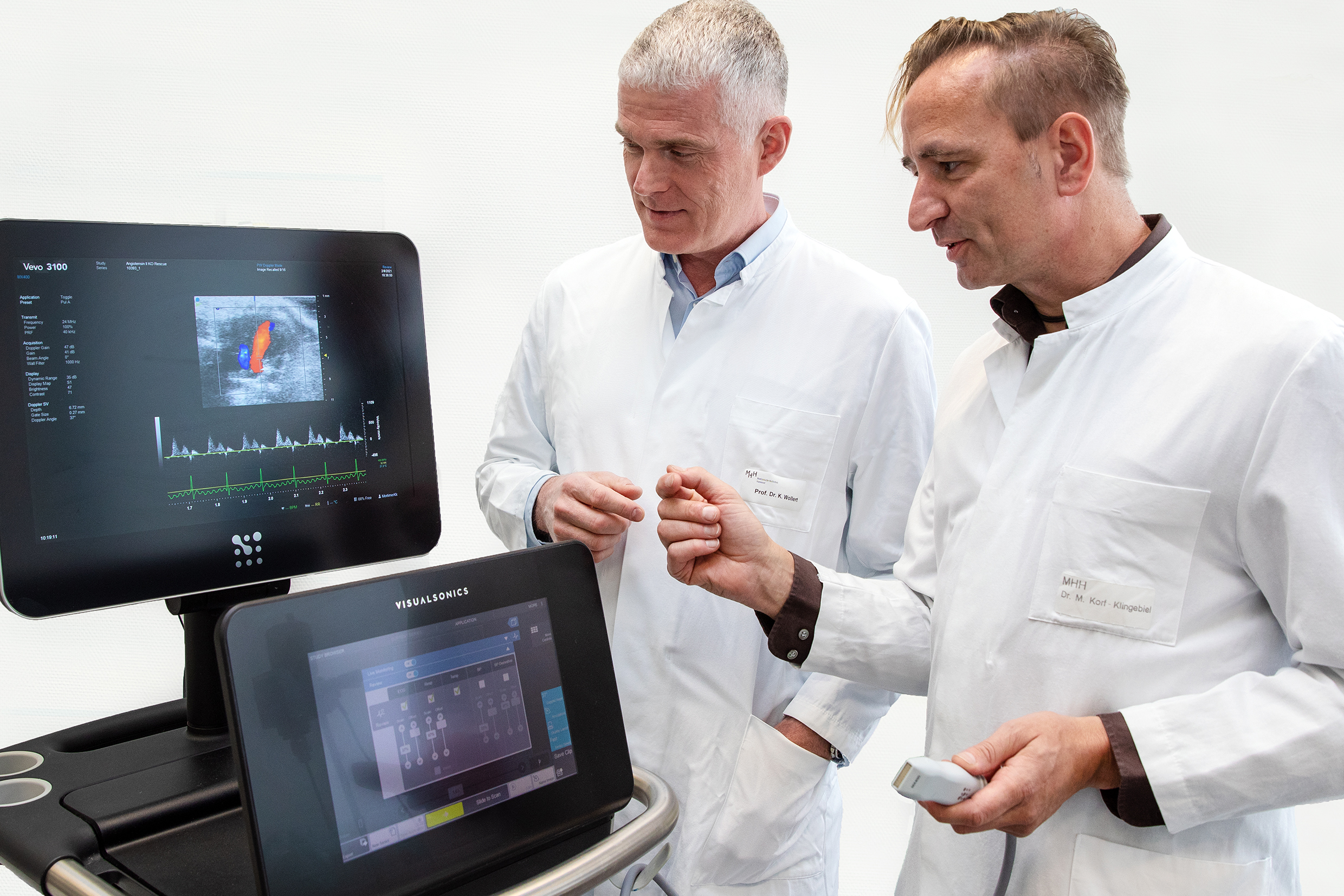MHH research team demonstrates how inflammatory cells improve the function of diseased heart muscle cells

Professor Dr. Kai Wollert (left) and Dr. Mortimer Korf-Klingebiel with the ultrasound image of a mouse heart; Copyright: Karin Kaiser / MHH.
14.10.2021
Heart failure or cardiac insufficiency is one of the most common causes of death in Germany and is caused by heart attacks, high blood pressure or heart valve defects. The heart is then no longer able to pump a sufficient amount of blood through the body and supply organs, muscles or other tissues with enough oxygen and nutrients. Those affected often suffer from shortness of breath and are only able to cope with everyday life to a limited extent. In Germany, around two million people suffer from heart failure, which is often accompanied by inflammation in the heart muscle tissue. This has a bad influence on the course of the disease.
Previous attempts to suppress the inflammation with the help of drugs were unsuccessful. This gave rise to the suspicion that the inflammation might also have its good side. Now, a research team led by Professor Dr. Kai Wollert, Head of Molecular and Translational Cardiology at the Department of Cardiology and Angiology at Hannover Medical School (MHH), has demonstrated for the first time how inflammation can support the weak heart. In this process, white blood cells that have migrated into the heart produce a growth factor called MYGDF, which improves the performance of the heart muscle cells. The work has now been published in the renowned journal Circulation.
White blood cells release growth factor during pressure load
Heart failure is one of the main areas of research at the Department of Cardiology and Angiology headed by Professor Dr Johann Bauersachs. "In heart failure, the weakened heart tries to compensate for its reduced pumping capacity by increasing muscle mass, i.e. by growing larger," explains Professor Wollert. Unlike a trained athlete's heart, however, this growth does not lead to better cardiac performance. The individual heart muscle cells become larger and larger, but their efficiency decreases and the organ becomes weaker and weaker due to the permanent pressure overload. Inflammatory processes triggered by white blood cells further worsen the heart's function. However, there are exceptions. In the mouse model, the research team has identified an interaction between certain inflammatory cells and heart muscle cells that protects the heart. Monocytes and macrophages play a crucial role. "These inflammatory cells release MYGDF during pressure overload, which inhibits pathological heart muscle growth and improves the function of the heart muscle cells," says the cardiologist.
MYGDF activates calcium pump in the heart muscle cells
MYDGF helps weakened heart muscle cells to function better again by influencing the calcium balance of the cell. In order for heart muscle cells to relax again after a heartbeat, calcium must be pumped back into a store inside the cell. The calcium is then available again during the next heartbeat. In heart failure, this calcium transport is disturbed and muscle strength decreases. "MYGDF upregulates the calcium pump so that the heart muscle cells can work better again," explains Dr. Mortimer Korf-Klingebiel, biologist and first author of the study.
Whether all of this is also significant for humans was investigated by the team in patients with heart failure due to aortic stenosis. In this disease, the heart valve between the ventricle and the aorta is severely narrowed, so that the heart has to work against increased pressure. Blood samples from these patients showed significantly elevated levels of MYDGF. When an artificial heart valve was implanted in the patients in the cardiac catheterisation laboratory, the MYGDF level dropped to normal. Pressure overload thus also leads to MYDGF release in humans.
The work shows that the positive aspects of inflammation must be considered when thinking about anti-inflammatory therapies for heart failure, Professor Wollert and his team emphasise. Moreover, the growth factor MYGDF could possibly be administered itself as a therapy for heart failure. "It already works pretty well in mice," says the cardiologist. In any case, the researchers have already filed a patent application for the use of MYGDF as a new drug for heart failure.
SERVICE:
For further information, please contact Professor Dr. Kai Wollert, wollert.kai@mh-hannover.de, telephone (0511) 532-4055.
The original paper "Myeloid-Derived Growth Factor Protects Against Pressure Overload-Induced Heart Failure by Preserving Sarco/Endoplasmic Reticulum Ca2+-ATPase Expression in Cardiomyocytes" can be found here.